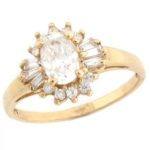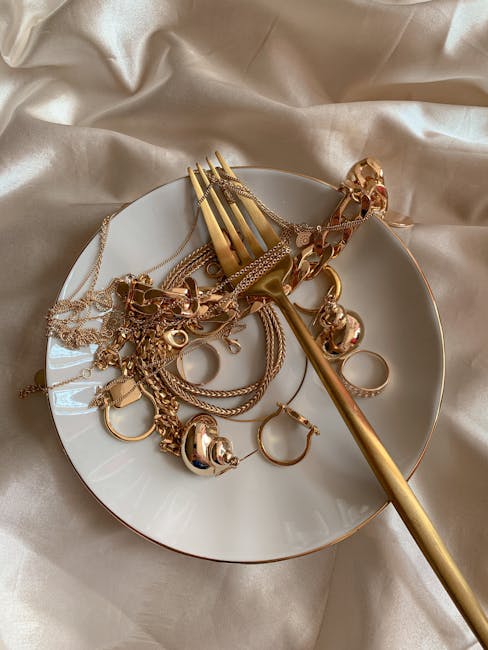The History and Evolution of Fine Gold Jewelry
Gold jewelry has captivated humans for millennia, adorning royalty, signifying wealth, and celebrating cultural milestones. From ancient Egyptian pharaohs to contemporary fashion icons, fine gold jewelry has remained a timeless symbol of elegance and prestige. In this blog post, we delve into the rich history and evolution of fine gold jewelry, exploring its journey through the ages and its impact on societies around the world.
Ancient Beginnings: The Birth of Gold Jewelry
The history of gold jewelry dates back to ancient civilizations, where it was often associated with divinity and power. Archaeological discoveries have revealed that gold was first used in jewelry around 4,500 BC in Eastern Europe, particularly in Bulgaria. Perhaps the most famous ancient civilization known for its exquisite gold jewelry is Egypt.
Egyptian Gold Jewelry
Ancient Egyptians were pioneers in goldsmithing, creating intricate pieces that were buried with pharaohs to accompany them in the afterlife. Gold was considered the “flesh of the gods” and was predominantly used in the creation of amulets, necklaces, and headpieces. Notable is the burial mask of Tutankhamun, crafted from 11 kilograms of gold, showcasing the craftsmanship of the era.
Mesopotamian and Greek Influences
Mesopotamia, another ancient civilization, also contributed to the early development of gold jewelry. Mesopotamian artisans created sophisticated gold necklaces, earrings, and headgear, often incorporating gemstones like lapis lazuli.
In ancient Greece, gold jewelry took on new forms, with the introduction of intricate designs like the “Heracles knot” and delicate filigree work. Greek goldsmiths were known for their mastery in creating fine gold jewelry that depicted gods, animals, and mythological scenes.
The Middle Ages: Gold Jewelry as a Status Symbol
During the Middle Ages, gold jewelry continued to symbolize wealth and power. Nobility and royalty adorned themselves with elaborate gold pieces, often set with precious gemstones. Goldsmiths during this period were highly skilled artisans who pushed the boundaries of design and technique.
Byzantine and Medieval Europe
The Byzantine Empire was known for its opulent gold jewelry, characterized by religious motifs and intricate enameling. Goldsmiths in medieval Europe followed suit, creating pieces that reflected the wearer’s status and religious devotion. Rings, brooches, and pendants were popular, often engraved with intricate designs and set with precious stones.
Renaissance Revival
The Renaissance era saw a revival of classical art and culture, which was reflected in gold jewelry design. Wealthy patrons commissioned goldsmiths to create bespoke pieces, leading to a flourishing of creativity and innovation. Jewelry from this period often featured motifs inspired by nature, mythology, and classical antiquity.
Modern Era: The Evolution of Gold Jewelry Trends
The modern era has witnessed significant changes in the design and production of gold jewelry. Technological advancements and changing fashion trends have influenced the evolution of gold jewelry, making it more accessible and diverse.
Victorian and Art Nouveau Periods
The Victorian era introduced sentimental jewelry, with pieces often featuring motifs such as hearts, flowers, and lockets containing hair or photographs of loved ones. Gold jewelry from this period was characterized by its romantic and ornate designs.
The Art Nouveau movement, which emerged in the late 19th century, brought a new wave of creativity to gold jewelry design. Art Nouveau jewelry featured flowing, organic lines and was often inspired by nature. Goldsmiths experimented with new techniques, such as enameling and the use of semi-precious stones.
20th Century and Beyond
The 20th century saw the rise of iconic jewelry houses such as Cartier, Tiffany & Co., and Bulgari. These luxury brands redefined gold jewelry, creating timeless pieces that continue to be coveted today. The Art Deco movement of the 1920s introduced geometric designs, while the 1960s and 70s embraced bold, statement pieces.
In recent years, there has been a resurgence of interest in sustainable and ethically-sourced gold. Consumers are increasingly conscious of the environmental and social impact of their purchases, leading to a demand for responsibly-sourced gold jewelry.
Key Milestones in the History of Gold Jewelry
Throughout history, certain milestones have marked significant advancements in the evolution of gold jewelry. Here are some key moments:
- 4,500 BC: The earliest known use of gold in jewelry, discovered in Varna, Bulgaria.
- 1,300 BC: Tutankhamun’s burial mask, a masterpiece of ancient Egyptian goldsmithing.
- 4th Century AD: The Byzantine Empire’s flourishing gold jewelry industry.
- 15th Century: The Renaissance era’s revival of classical motifs in gold jewelry.
- 19th Century: The Romantic and ornate designs of the Victorian era.
- 1920s: The geometric and modernist designs of the Art Deco movement.
- 21st Century: The rise of sustainable and ethically-sourced gold jewelry.
Actionable Tips for Buying Fine Gold Jewelry
If you are looking to invest in fine gold jewelry, here are some actionable tips to help you make an informed decision:
Understand Gold Purity
Gold purity is measured in karats, with 24K being pure gold. However, pure gold is soft and prone to damage, so it is often alloyed with other metals to increase its durability. Common purities include 18K (75% gold) and 14K (58.3% gold). Understanding the purity of the gold will help you determine its value and suitability for everyday wear.
Check for Hallmarks
Hallmarks are official marks stamped on gold jewelry to certify its purity and authenticity. Look for hallmarks such as “18K” or “750” (indicating 75% gold) to ensure you are purchasing genuine gold jewelry. Additionally, check for the maker’s mark and country of origin.
Consider the Design and Craftsmanship
The design and craftsmanship of gold jewelry can significantly impact its value and desirability. Look for pieces that exhibit fine detailing, symmetry, and a high level of craftsmanship. Pay attention to the setting of gemstones and the finish of the gold.
Research the Brand or Jeweler
Purchasing gold jewelry from a reputable brand or jeweler can provide assurance of quality and authenticity. Research the brand’s history, customer reviews, and their policies on returns and warranties. Established brands often have a legacy of craftsmanship and trustworthiness.
Consider Ethical and Sustainable Options
As consumers become more environmentally conscious, the demand for ethically-sourced and sustainable gold jewelry is on the rise. Look for jewelers who use recycled gold or source their gold from mines that adhere to ethical and environmental standards. Certifications such as Fairtrade Gold can help you identify responsible choices.
Conclusion
The history and evolution of fine gold jewelry is a testament to humanity’s enduring fascination with this precious metal. From ancient civilizations to modern times, gold jewelry has been a symbol of wealth, power, and beauty. As you explore the world of fine gold jewelry, understanding its rich history and the craftsmanship behind each piece can deepen your appreciation and guide you in making informed choices.
Whether you are a collector, a fashion enthusiast, or someone looking to invest in timeless pieces, the journey of gold jewelry through the ages offers a wealth of inspiration and insight. Embrace the legacy of gold and let it continue to shine brightly in your life.

